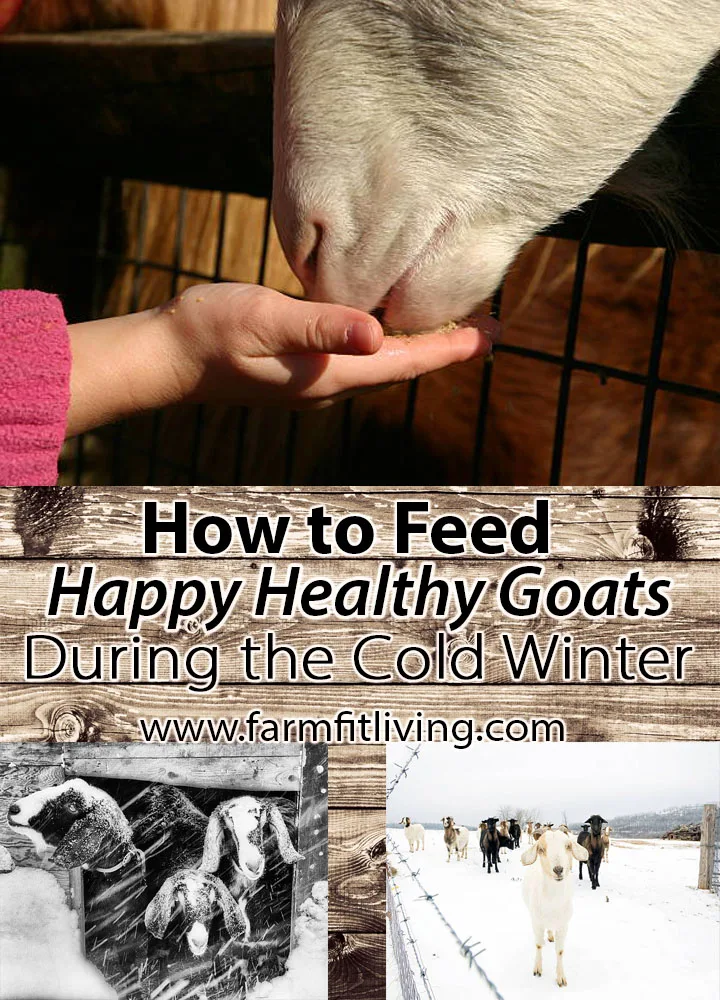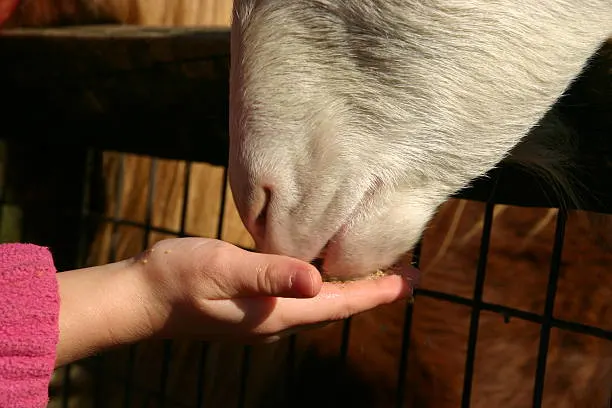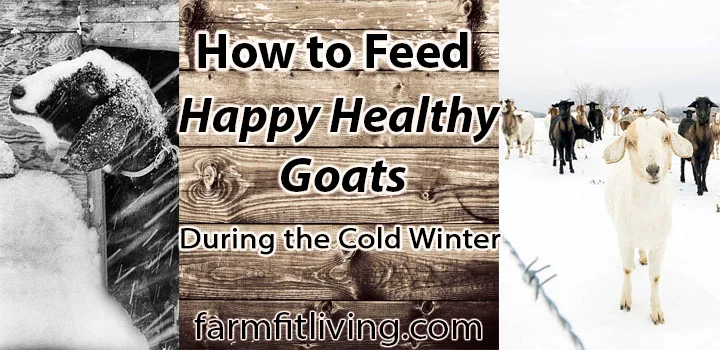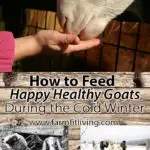Are you concerned with how to feed happy healthy goats during the cold Winter?
Or maybe you’re more concerned with needing to feed happy healthy goats more cost effectively. More efficiently? We all value our money and time…and our goats, too. We want them to be happy and healthy.
It’s very true that the topic of feeding goats is broad and everyone has their very own opinion about how it should be done. After more than a decade of raising meat goats, I admit I have tried so many products and methods and feeds for goats that were out on the market.
And while not all of them worked as well as some, I’m here to day to share the mistakes and the success I’ve found with feeding goats through the winter.
In this post, I’ll share:
– How to feed healthy happy goats during the winter,
– Things to keep in mind when you’re looking for the right nutrition for goats,
– How much to feed goats and how often,
– What to look at when you’re trying to decide how to feed your goats,
– And More.
I hope this post will be valuable for you. There’s a lot of information, so I’m going to try to break it up in a way that’s easy for you to read. Let’s dive in.

How Much Energy Do They Need?
Different types and breeds of goats actually require similar nutrients. That really isn’t so much of an issue.
However the change comes with the amount of energy that each individual animal uses. Within each group of goats, there might be different goats using different amounts of energy that will require more energy.
These classes include:
– Pregnant Does,
– Lactating Does,
– Older or Thin Does,
– Goats that are growing.
These groups of goats in their seasons are using a lot of energy and could get run down in the stress of the cold if not supplemented. On the other hand, if you have bucks or does that aren’t working, they will do just fine consuming less.
You just need to keep body condition score in mind. Let’s discuss this next.
Body Composition Score
I talk about body condition score (BCS) in one of my other Winter goat posts about Winter goat care. You can find that post below but I’ll talk about BCS here now.
BCS is a simple numbering system used to determine if your goats are holding good weight, maintaining weight or getting too thin. You decide what that score is on your goats. Here’s the numbering system with descriptions:
1: Deathly thin. You should be able to see ribs and the backbone and the goat may act weak. Definitely take a fecal and start deworming. Increase the feed and you might even have to keep the goat by themselves until they gain adequate weight. It also wouldn’t be a bad idea to see a vet.
2. A little too thin. Increase minerals and protein. Take a fecal sample to check for parasites. Provide plenty of feed.
3: Perfect condition. Goats need to maintain this condition through the winter. Make sure you’re feeding enough but increase if lactating or growing.
4: Good condition. Might be a little on the heavy side. Feed the minimum amount but no more.
5: Goat is overweight. Limit the feed or feed hay and minerals only.
Keep in mind that these numbers depend on the size and frame of the does. Never ignore a doe that is BCS 2 or 1. If your goats get to a 2, you should really consider feeding extra and checking for parasites.
How Often Should We Feed Goats?
I get this question a lot. My answer is that it depends on your time and your goats.
There’s no right or wrong way to feed goats. But you need to make sure your goats are getting all they need to be healthy and happy.
You need to decide one daily ration for your goats. It needs to be a Calcium/Phosphorus ratio of 2:1 – 4:1, high protein and nutritious. They need to have good forage in their diet as well to help their ruminant stomachs work.
If you’re unsure as to how to formulate a diet, you can work with a nutritionist to formulate a good diet or buy a proven diet from your local feed store.
Once you know what that diet is, it’s up to you for how often you feed your goats. Feed the whole ration once per day. Or break it up in to twice per day feedings but don’t feed extra unless their BCS is less than 3. It also depends on the amount of stress they will be under due to the Winter weather.
Hay Options
Goats must have forage in their diets. And in many places during the Winter, the
Baling hay during the peak season of the grass or
Legume
Oat
Alfalfa
Brome
Orchard
1 round per month and at least 2 backup
Guinea Linx web site has a great hay chart that tells you how much dry matter, Ca:P Ratio and nutrient value many different types of hay contains. See that chart here.
Hay is really a very safe option. But what about grains? Should you feed them? Let’s talk about that?
Do Goats Really Need Grain?
Over the past 10 years, we have tried many different experiments based upon what other breeders have done. One of those is the “no grain” diet.
There are plenty of people out in the world who believe animals should be completely grass fed. That grains are not good for animals. So, as farmers and educators, we took on the challenge of not giving a group of goats any grain during the winter.
It did not go well. We found that even our hay was not enough protein and nutrients to help the goat remain healthy and happy. They lost bone density and weight and seemed to be hungry all the time. After a few weeks, we gradually added some grain into their diet.
The result was mind blowing. Since then, we always feed some kind of grain to our goats during the winter. The rest of the year? No, we make sure they have enough browse and minerals. But they are getting what they need while browsing.
I definitely recommend feeding goats a good healthy protein feed during the winter months. Here’s some things to keep in mind when choosing a good feed.

Feed Options for Goats
There’s so many options for goat feeds out there! How do you choose?
Well, there’s some things to keep in mind:
– Your budget,
– What is available to you,
– What is local,
– Nutrient Value,
– What’s your goal with your goats.
I recommend beginning with a good 16-18% protein goat feed. It can be a pelleted or a textured feed – my goats do very well on both. Also, make sure that the Ca:P ratio is from 2:1 to 4:1.
Then, feed according their body weight. Start with about 3% of their body weight per day and see how they do with that amount. Add in some hay for roughage, water and minerals.
You can buy a bagged feed from a feed store or grind your own at the local coop. We have done both and it’s about the same cost in the end. It’s really not that much more expensive to buy a brand name feed, although, some brands are more expensive.
I also recommend scoping out your area to see what others are feeding their goats and doing what they do what is already working.
Good Protein Sources
As I’ve discussed above, poor or trace levels of protein in the goats’ diets can negatively affect growth rate, milk production, reproduction and disease resistance in their bodies. They need protein in their diets to be healthy and happy.
The right protein content for a goat is 16-18% protein. Too much protein is not stored in the body, but excreted in the urine. So, too much protein isn’t necessarily a good thing. When it’s cold, they need to have enough.
Here’s some protein sources you might be able to access that are recommended for livestock feed:
– Soybeans,
– Sunflower Meal,
– Cow Peas,
– Sesame,
– Chickpeas.
Talk to your Coop or feed store nutritionist to find out more in your area. It’s most important to keep your goats’ feed balanced and as healthy as possible.
What about Carbohydrates?
Carbs are needed for energy. They are so important to help goats get through a cold day. They increase weight and help keep the animal warm.
Corn is a very good example of a carb and it’s very readily available in most areas of the country. Some other good examples of carbs include:
– Beet Pulp,
– Silage,
– Barley,
– Cottonseed.
Again, work with a feed nutritionist to make sure your ration is balanced for goats.
What Else?
There are many other nutrients you need to include in your goats’ diets.
Minerals and vitamins such as Thiamine, Calcium, and copper are all very important. There are a number of supplements you can use to add these into your goats’ diets. One of them is called Replamin that many goat producers use.
We use the Cargil Onyx Right Now Cattle mineral. It’s a very high quality mineral that contains ample amounts of copper for goats. We’ve had great luck with it.

Know How to Feed Happy Healthy Goats This Winter
As I’ve mentioned, the topic of how to feed happy healthy goats is very broad. It highly depends on what is available to you and also the needs of your goats.
Goat’s need:
– A high protein balanced 2:1 Ca-P Diet,
– Good Quality Hay for Roughage,
– Minerals.
But I hope I’ve given you the next step. The step you need to take to help your goats stay strong and healthy all Winter. I’ve given you some options for monitoring your goats’ body condition and balancing a feed ration for them for the winter.
And I know your goal is happy healthy goats. My goal is to provide you with enough information so that you can make the right decision for you and your goats.
Please let me know in the comments if this post has helped you.


Disclaimer: I am not a veterinarian. However, I do have a 4 year degree in Animal Science & Industry from a University, a Master’s degree in Agricultural Education & over a decade of experience raising goats. I believe it’s my duty to share those experiences with other goat producers. I work very closely with my own veterinarian whom I trust and seek advice from on the regular. Both of us are human beings – Not Super Heros. Read more here…

